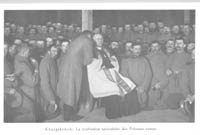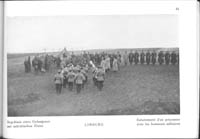Table of Contents
Media Index
CHAPTER 19
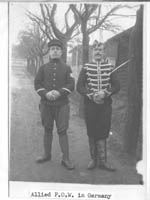
A pair of Allied prisoners, a French soldier and a Belgian trooper, pose for a photograph for a WPA secretary in Germany.
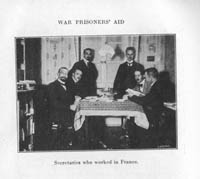
Photograph of six World's Alliance WPA Secretaries who provided POW relief services to German prisoners in France during World War I. Emmanuel Sautter, a World's Alliance General Secretary, stands by the window to the left; he served on the World's Committee from 1911 to 1917, but requested a furlough from the World's Alliance in 1914 to establish Red Triangle services in France at the beginning of the war.
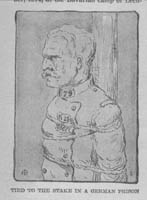
This drawing shows a French prisoner of war tied to a stake for some infraction of the camp regulations in a German POW camp. The prisoner was forced to stand for hours outdoors in all sorts of weather. The POW suffered from fatigue, sleep deprivation, and exposure from this type of punishment.
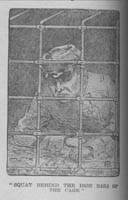
For punishment for breaking camp rules, prison authorities would force prisoners into iron cages which were not large enough for the POW's to stand up or lie down. The prisoner's limbs were always cramped and many thought that this was the most severe form of punishment the Germans employed during the war.
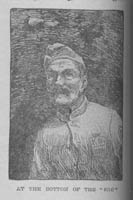
In this drawing, a prisoner sits in solitary confinement in the "silo," a deep hole in the ground with the top open to the elements. Guards threw food down to the prisoners, who were forced to live in their own filth for days at a time.
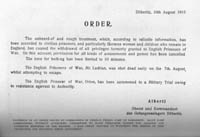
Colonel Alberti, commandant of the prison camp at Doeberitz issued this order ending entertainment and games and limiting bathes to ten minutes on 10 August 1915 as a reprisal for alleged mistreatment of interned women and children by the British government in English internment camps. YMCA secretaries had a difficult time trying to expand War Prisoners' Aid services to POW's as belligerent governments responded harshly to claims of mistreatment of their nationals with reprisal orders. Note the death of the prisoner who failed in his escape attempt.
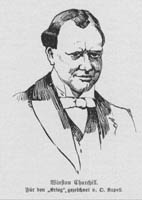
Pen and ink drawing of Winston Churchill (1874-1965), British First Lord of the Admiralty until his resignation in 1915 after the failed Gallipoli campaign.
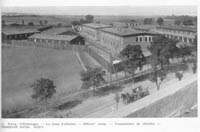
This aerial photograph shows the officers' prison camp at Burg, including the main brick buildings and the newly constructed wooden barracks that made up the prison compound.
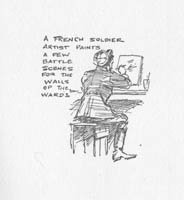
As a punishment camp for Allied officers, usually men who had attempted to escape from other camps, there were not many options for prisoners for recreation. This French prisoner is passing time by drawing sketches of battle scenes to decorate the walls of the ward at Koeln.
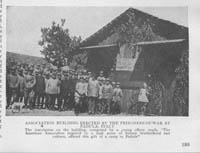
Italian troops and an American YMCA secretary, in civilian clothing, stand outside the newly inaugurated YMCA building at the POW camp in Padula, Italy. The American YMCA provided the funding for the building and Central Power prisoners of war provided the labor in the hut's construction.
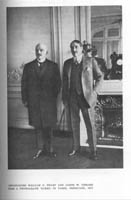
James W. Gerard (1867-1951), right, U.S. ambassador to Germany, stands next to William G. Sharp, U.S. ambassador to France, in Paris in February 1917, after the Wilson administration broke off diplomatic relations with Germany.
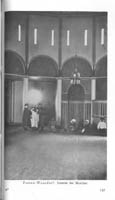
The interior of the mosque at Zossen-Wunsdorf, a gift to Islamic prisoners from Kaiser Wilhelm II. Several men are studying the Qu'ran inside the building. Arabic inscriptions from the Qu'ran decorate the walls of the building.
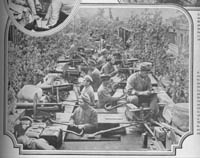
Troops of the Czech Legion man a considerable number of machine guns on an armored train somewhere in Russia. The car is camouflaged with branches to protect the gunners. The Czechoslovak forces gained control of large tracts of the Russian railway system as they fought their way east to reach Vladivostok and transportation to the Western Front.
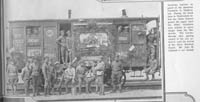
This photograph shows a YMCA club car assigned to serve the soldiers of the Czech Legion somewehere in Russia. An American Red Triangle secretary served these men the same hospitalities as an Association hut except the care moved with these forces across Siberia as part of the military train. The car is decorated with slogans, pictures, and flags as well as declarations of their intended route: Vladivostok to Paris to Prague.

British prisoners collect water at the hand pump so they can wash their clothing in the large outdoor tubs at Limburg. The barracks where they ate and slept stand behind them.
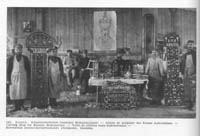
Russian Muslim prisoners display some of the fine handicrafts in the carpentry shop at Zossen-Wuensdorf. The prisoners have carved three street signs (two for Yorkstrasse and one for Lowenfeldstrasse) while a design hangs on the wall. Note the picture of Kaiser Wilhelm II on the back wall to the left.
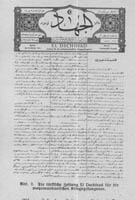
Front page of the El Dschihad (The Jihad), the newspaper for Muslim POW's at Zossen-Wuensdorf. This was issue Number 45 (31 October 1916) and was printed in Berlin. The Germans issued this newspaper as a propaganda tool in Arabic, Turkish, Persian, Urdu, and Hindi to influence Muslim prisoners.
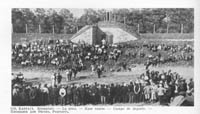
Prisoners compete in a foot race, watched by a large crowd of spectators at Rastatt. Note the sentry box on top of the building which may have been a magazine. Athletic competitions kept the men in shape and provided diversions for the camp population.
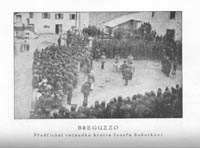
A member of the Czechoslovak Legion, Josefu Sobotkovi, faces an Austrian court martial in this courtyard in Breguzzo, Italy. If the drumhead council found Sobotkovi guilty of treason, he would receive capital punishment.
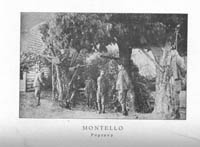
Five Czechoslovak Legionnaires hang from makeshift gallows from trees in Montello, Italy for fighting for Czechoslovak independence with the Allies. Austro-Hungarian authorities charged these prisoners with treason and found them guilty.
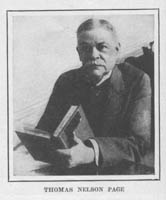
Photograph of Thomas Nelson Page (1853-1922), United States ambassador to Italy from 1913 to 1919; he supported the organization of the American YMCA WPA operations in Italy.
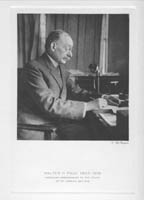
Walter Hines Page (1855-1918), United States ambassador to Great Brtiain from 1913 to 1918, works at his desk in the embassy.
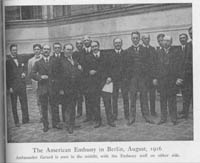
This is a photograph of the U.S. embassy staff in Berlin in August 1916. Ambassador James W. Gerard stands in the center of the group, holding some papers. These men were responsible for the official inspection of German treatment of Allied prisoners of war in the Kriegsministeriums prison camp system and reporting their findings to the Entente governments.
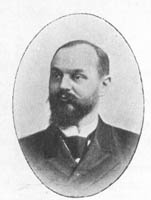
Christian Phildius (d.1937) worked hard during World War I to maintain the cohesion of the World's Alliance of YMCA's and to ensure its status as a viable international organization to address post-war needs. He often found himself in the position of negotiating between the various national Associations while trying to preserve Red Triangle services to POW's, soldiers, and war victims.
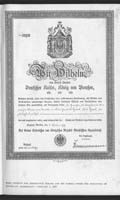
The German Government issued Ambassador James W. Gerard (1867-1951) this safe conduct pass which allowed the ambassador, his family, and staff to travel in safety to Switzerland after the Wilson administration broke off diplomatic relations with Germany in February 1917. Most American Red Triangle workers working on WPA operations in the empire departed Germany on this train.
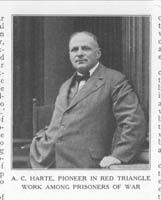
Archibald C. Harte (1865-1946) gained access to German, Austro-Hungarian, and Russian prison camps for the American YMCA and became the General Secretary in Europe for War Prisoners' Aid operations.
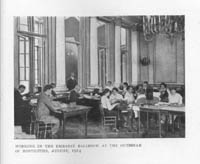
American volunteers and embassy staff members work in the ballroom of the U.S. Embassy in Berlin in August 1914. With the outbreak of war, thousands of American tourists sought to return home and the staff soon found itself overwhelmed by the demands of protecting Allied interests in Germany.

A stout German non-commissioned officer counts off Russian prisoners during a roll call at Buetow. Note the wooden barrack under construction in the background.
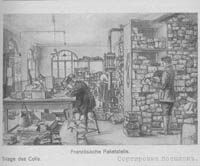
Once parcels were cleared by the German military inspector, French prisoners prepared the parcels for distribution to the POW's. This water color drawing illustrates the French parcel post office at Muensingen.

The American YMCA and six other social welfare agencies conducted a coordinated national fund-raising campaign from 11-18 November 1918 to secure money to support relief operations around the world. The United War Work Campaign became the model for today's United Way campaign as welfare organizations seek modest contributions from large numbers of subscribers. President Woodrow Wilson urged Americans to generously support the efforts of these organizations.
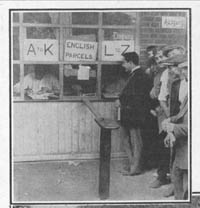
Interned British civilians line up to receive their packages at the Parcel Post Office at Ruhleben. The smiles on the faces of the men reflect their eagerness to obtain their parcels.
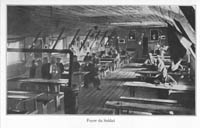
View of the interior of a Foyer du Soldat, somewhere in France during World War I. French soldiers sit at tables and read or write letters. The foyer is heated by a wood stove and the YMCA secretary has decorated the hut with pictures and flags.
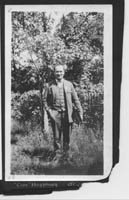
Post-war photograph of Conrad Hoffman (d. 1958), the Senior American YMCA WPA Secretary in Germany during World War I. This picture was taken after Hoffman began working with Austrian students.
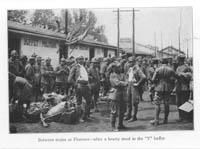
Italian troops wait for their train after they enjoyed a meal at the YMCA military canteen at the train station in Florence. The Association agreed to supervise this service for soldiers at the request of the Italian government because the previous operators sold poor quality food at high prices. Note the American and Italian flages above the door of the canteen.
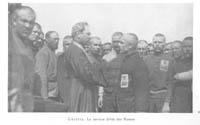
Bareheaded Russian prisoners participate in an outdoor religious service in the prison compound at Goerlitz. They receive a blessing from a Russian Orthodox priest.
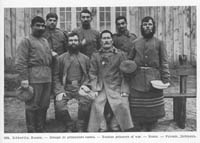
A group of Russian prisoners of war at Doeberitz, representing a wide range of nationalities in the tsarist empire, stand in front of their barrack.
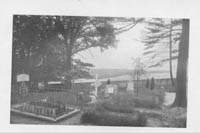
Photograph of the well-tended prison camp cemetery at the officers' camp at Koenigstein. Most of the graves are decorated with flowers and plants or iron railings.
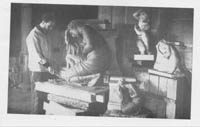
A French sculptor works in his workshop at Guestrow on a statue which will be part of a POW memorial in the prison camp cemetery. There are three other statues under construction which will commemorate fallen comrades from the prison.
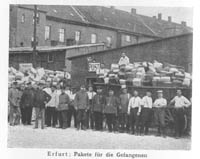
French prisoners of war and German non-commissioned officers pose in front of a wagon filled with recently arrived parcels outside of the Post Office at Erfurt. A pile of parcels stands to the left behind the prisoners. German censors will inspect all of these packets before they are distributed to the prisoners. The photograph shows a number of buildings in the prison compound.
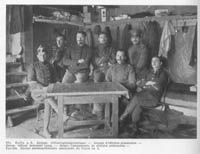
Russian, French, and Belgian officers pose around a cloth-covered table in the prison camp in Halle-am-Saal. The belongings of the officers assigned to this room sit on the shelf and include boxes, photographs, bowls, and cups, while clothing and a pocket watch hand from the shelf.
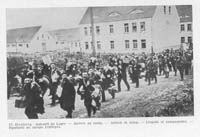
Newly arrived French prisoners march into the prison camp at Heuberg carrying their worldly belongings over their shoulders, under Landsturm guard.
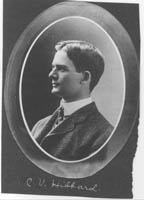
Portrait of a young Carlisle V. Hibbard (1876-1954); he negotiated with the French and British governments to begin WPA operations in 1915; he became the Associate General Secretary of the National War Work Council in New York after returning from Europe.
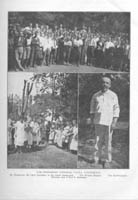
This montage shows various scenes from the Hungarian National YMCA Conference held in 1921. After the war, the Association expanded its efforts to develop the Hungarian YMCA. Magercsy, the Secretary General of the National Hungarian YMCA Committee, stands in the middle foreground of the top photograph amid the other delegates. Women supporters pose in the photo to the lower left, while a former prisoner of war and new Red Triangle secretary is featured in the lower right photograph.

Photogaph of Edward T. Heald (1886-1967) in his YMCA uniform in 1917; he was an American WPA Secretary who served in Russia and assisted the Czech Legion as they advanced along the Trans-Siberian Railway during the Russian Civil War.
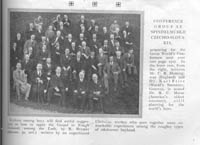
This group photograph shows the national representatives of YMCA's from around the world who met at a conference in Spindelmuehl, Czechoslovakia in 1920. They gathered to prepare for the first World's Conference after World War I and delegates included Karl Fries, former Secretary General of the Swedish YMCA and Secretary General of the World's Alliance of YMCA's, and Richard Morse, the former Secretary General of the American YMCA.
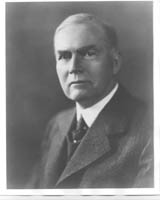
Photo of an older John R. Mott (1865-1955), General Secretary of the International Committee of the American YMCA from 1915 and General Secretary of the World's Committee of the World's Alliance in 1926.
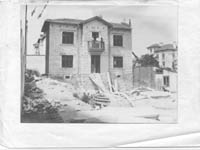
View of the construction of the YMCA Vocational Technical College in Bulgaria after World War I. The American Associaiton established a vocational technical college to teach Bulgarian young men and Russian refugees a wide range of new trades. The vocational technical college was an innovation in European education.

British, Russian, and Serbian prisoners of war stand at attention in the prison compound at Stargard in the presence of a German nurse. The photograph aptly demonstrates the pitiable condition of Serbian prisoners who wear rags for uniforms.
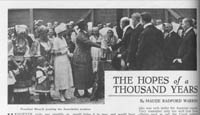
Thomas Masaryk, President of the newly independent country of Czechoslovakia, formally welcomes an American secretary in a ceremony. Women and girls in native costumes stand to the left and behind the female American Y secretary. The Czechoslovaks welcomed the Association to establish Red Triangle programs across the breadth of the new republic.
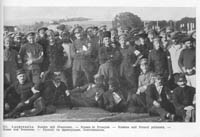
A large group of Russian and French POW's (including a Senegalese prisoner on the ground in the front row) pose for a photograph in the prison compound at Langensalza. Note the POW identification badges on the left arms of the prisoners.
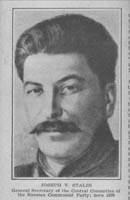
Photograph of a young Josef Stalin (1879-1953), Bolshevik leader and General Secretary of the Soviet Communist Party by 1922; he established a dictatorship and ruled Russia until his death in 1953.
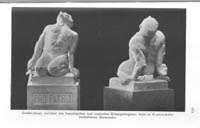
French and Russian prisoners made this statue of a suffering man with a drawn sword in memorial to their fallen comrades at Grafenwoehr. The memorial has a Latin inscription, "For the Fatherland," and was dedicated at the prison cemetery.
